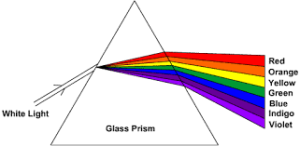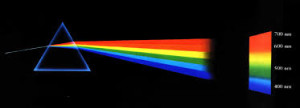-
Goethe’s Colour Spectra.
Posted on November 8th, 2014 No commentsYesterday, 7th November 2014 I was searching Google Images for suitable photographic images to add into my post “Williams’ Pin Prism, and Fraunhofer Lines.”. This was not an easy task because most images do not show the true visual evidence and are more computer graphics than reality. However, the task was definitely worthwhile, because I came across an image originally produced by Johann Wolfgang von Goethe. (1749 – 1832)
Most modern images are similar to the ones below.
These images are totally against the reality of what happens with prism spectra, and I find it very annoying , especially when being used to teach people.
Note; I have been sent this video clip from a reader who asked me to explain it.
http://www.youtube.com/watch?v=7Fl0GZsBhGo&NR=1
I am afraid that the contents of it demonstrate the poor teaching and lack of honesty in modern physics.
The drawings below, originally created by Goethe. and re-created by www.handprint.com are very close to the actual/true situation. His method/style used is identical to that used by myself, so he definitely beat me to it.
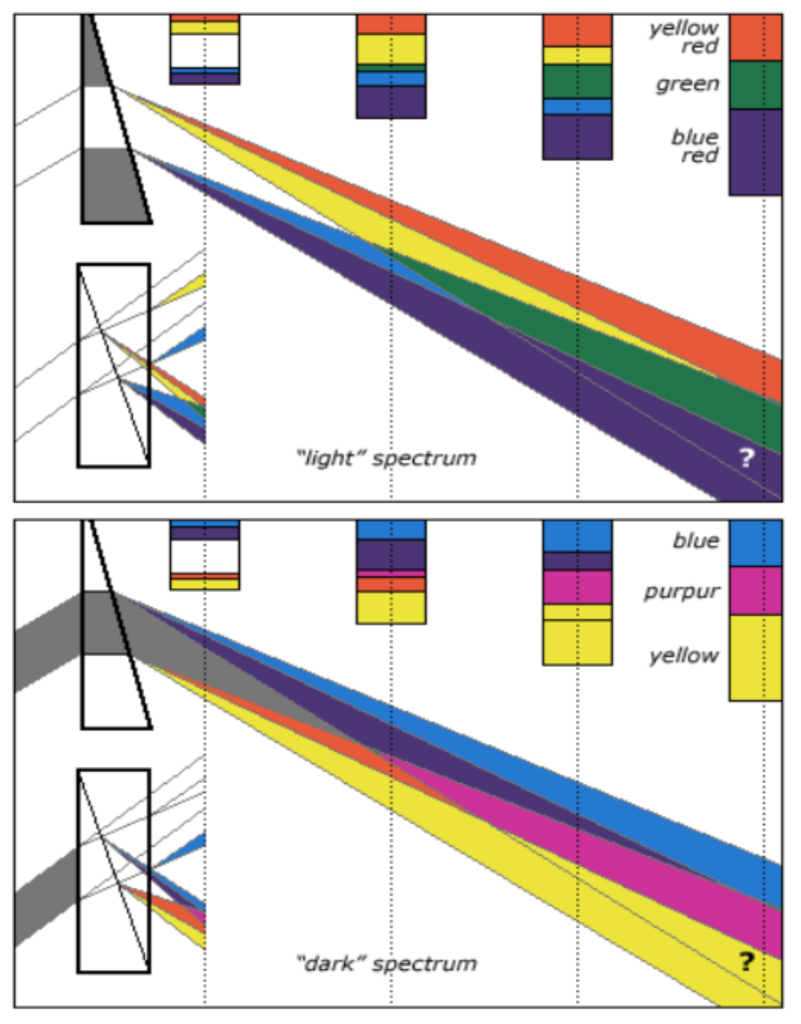 handprint : goethe’s “zur farbenlehre” www.handprint.com380 × 555Search by image
handprint : goethe’s “zur farbenlehre” www.handprint.com380 × 555Search by image“light” and “dark” spectral mixtures from. Goethe’s “primordial” fringes adapted from Plate IV, Figures 1 and 2 and ¶214-¶216 of Zur Farbenlehre (1810)
I assume that the above colours are based on the actual colours seen in the original book, which will have faded. In the top picture the Green shown should be a very bright Green.
The lighter Blue should be Cyan.
Where the question mark is, this area should be a dark Green.
The top picture (“Light” spectrum) is what I refer to as an “Expansion Spectrum”.
The bottom picture (Dark” spectrum) is what I refer to as a “Compression Spectrum”.
In this picture, where the question mark is, this area should actually be very pale Mauve or White. “Purpur” should actually be Magenta. Magenta only occurs in compression spectra and Greens only occur in expansion spectra.
Note; It is the slit, (that constricts the light into a beam), that actually creates the colours. The White beam entering the prism has thin Yellow + Red + Blue edges to it. This is why the colours start at edge of the spectra exiting the prism, as shown in the above drawings. What is missing from the top drawing is the dark Blue band. Its energy is measurable and is named “Infra Red” due to lack of knowledge, by the physicists. It is missed because this ‘true’ spectra Blue is very dark and is ‘lost’ against the dark background. The lighter Blues are a mixture of either Blue and White or Blue and Red.
In the drawing below, the left hand side (White) is the source of the light. This light passes through an aperture (Slit) and shines onto the prism.
 In passing through aperture, narrow coloured edges are created on each side of the beam of light. These edges are composed of three colour bands, Blue on the outer edge, Red in the middle and Yellow on the inside These edges are created by the Laws of Fluid Mechanics. If you look under “Orifices” in your text book on Fluid Mechanics, all should be explained.
In passing through aperture, narrow coloured edges are created on each side of the beam of light. These edges are composed of three colour bands, Blue on the outer edge, Red in the middle and Yellow on the inside These edges are created by the Laws of Fluid Mechanics. If you look under “Orifices” in your text book on Fluid Mechanics, all should be explained.See also my “Taper Slit Experiment” and my “Taper Silhouette Experiment.
Author – Brian Williams
-
Rainbows
Posted on July 26th, 2010 No commentsThe physicists claim that rainbows are created by light being split into different colours by tiny droplets of water. This is only partially true. If you shine White light into a droplet of water you get White light. If there is an edge between the droplet and the light, or an edge visible through the sphere then you get distorted coloured bands. Coloured light entering a droplet of water is distorted in a similar way that coloured light entering a prism is distorted.
Where are the edges up in the sky to create these colour bands? These are provided by the droplets of water themselves. If you shine White light onto a droplet of water a shadow is formed behind it. The edges of this shadow create thin colour bands (Blue, Red and Yellow) that pass into droplets of water behind it and are distorted and enlarged. After that it becomes complicated as the coloured bands pass through millions of water droplets.
It is easy enough to check this with the use of a couple of brandy glasses filled with water.
-
Projected Light
Posted on November 22nd, 2009 No commentsFig.1 shows the overlapping light beams as shown in most books on physics to try to convince the public that white light is composed of all the other colours.
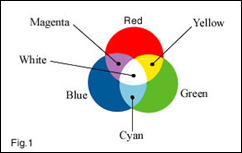
Unfortunately the illustration does not show the actuality, because there are no neat uniform areas of colours as shown. The light projectors do not project an even circle of colour as shown because the high intensity white beam always shows through the filters.
Consider the following extract: ‘It is an advantage if the projectors are controlled by rheostats, so that the relative intensities can be controlled in order to produce a good white’. From PHYSICS – An Examination Course. By E. L. Hansen. Hulton Educational Publications Ltd. In other words, if the physicists cannot obtain the results that they want, they are allowed to cheat. To be fair they don’t understand that it is cheating.
If you look at a Blue filter lying on a white sheet you see an even blue shade across the whole filter. If you shine a light through any filter you get results similar to those shown below.
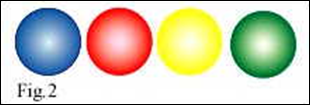
It is obvious that a considerable amount of white light is coming through the filters. If we re-label the above drawing to allow for this white light we arrive at the following drawing.

In the above drawing we are looking at the combined colour energy levels in particular areas. We are also getting dangerously close (If you are a physicist) to the artists colour mixing principles.
In the ‘Yellow’ area the combination of colours would give a yellow ochre. In the ‘White’ area the combination would give a very light grey. The white intensity from the lamps is very much higher than the white intensity from a ‘White’ screen, and therefore a relatively small amount of white light has a far greater impact than you would expect. Referring back to the chapter on the energy value of coloured light, the white light from the lamps has a probable intensity of at least 10 times greater the yellow light from the filters.
See ‘The Origin of Colour’, Taper Slit experiment, Taper Silhouette Experiment.
Technorati Tags: Projected Light,Colour,Colour – New Experiments,First published November 22nd 2009 -
Colour – Williams’ Taper Silhouette Experiment
Posted on November 22nd, 2009 No comments.
For our second experiment we use a tapered silhouette as shown.

If you view this silhouette through a prism you will see a spectrum as shown below.

In the above view the Blue and Red bands are forced into occupying the same space, therefore the combined energy plus some turbulence gives us Magenta. Where you would expect Green i.e. where the Blue and Yellow bands cross, you have the extra energy of the Red light in the Magenta which is being squeezed into the same area. This forces the total energy back into White. This I refer to as a ‘compression spectrum’.
It should be remembered that in the slit experiment the light can expand into the dark area. In the silhouette the colour bands are under pressure from the surrounding White light. Regarding the hypothesis that Yellow light is a combination of Red light and Green light, there is no evidence of any Green light. If there was a Green band between the Yellow band and the surrounding White I might have been interested in the hypothesis.
Note: Light acts in exactly the same way as any fluid, and follows the laws of fluid dynamics.
Abstract from Physics or Fantasy – Section 2 – Colour and the Quantum Theory
See also Williams’ Taper Slit experiment
-
Colour and the Prism
Posted on October 26th, 2009 No commentsWe are taught at school that a prism splits White light into its component colours. This is not true. Pass White light through a prism and you get White light. You cannot see a spectrum through a prism unless there is an edge visible. It is the edge that creates the colours, by reducing the energy of the light passing the edge, in the same way that water passing through an orifice has a reduced flow-rate adjacent to the edge of the orifice.
“Grimaldi has inform’d us, that if a beam of the Sun’s light is be let into a dark room through a very small hole, the…, and that these shadows have three parallel Fringes, Bands or Ranks of colour’d Light adjacent to them.”
From Sir Isaac Newton’s ‘The Third Book of Opticks’, fourth edition, first paragraph, originally published 1730, Dover Publications, Inc, New York. Standard Book Number: 486-60205-2
It is clear therefore that the creation of colours by an edge has been known to science for nearly 300 years. However I have never seen any mention of this in any modern book on physics.
This discovery by Grimaldi – Italian physicist – (1618-1663) was quite important, but its main significance was missed by the physics establishment, (Possibly not true of Newton, because he was quite devious in many ways, and his inclusion of the above paragraph as the introduction to Book Three would indicate that it had particular importance to him.)
It is also obvious from the above that the edge creates THREE colour bands, not 6 or 10 or 20 or 50. These bands are the Dark Blue, Red and Yellow referred to in this web site. from which all other colours are derived. Although you can understand it being missed 300 years ago, there is no excuse in modern times for this evidence being ignored. The problem was (and still is), that it had already been accepted by the physics establishment that White light was a combination of all the other colours.These coloured edges are commonly visible when looking through windows at a bright sky. The window is a wide slit. The shadows on both sides of a beam of light coming through a slit have coloured edges. We should really say that the White light passing through the slit has differently coloured edges.
A prism does not split White light into the different colours. but makes the colours created by the edges of a slit more readily discernible. If the slit becomes too narrow the coloured edges meet and give the distorted and blurred spectrum that physicists claim as a ‘true spectrum’.
See also Taper Slit Experiment, Taper Silhouette ExperimentFirst Published October 26th 2009


